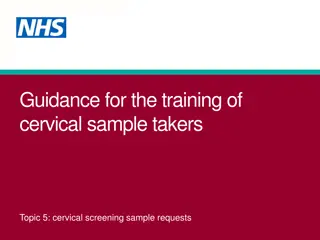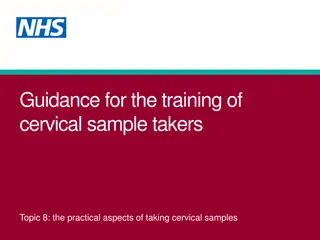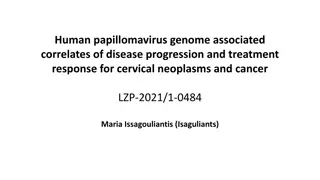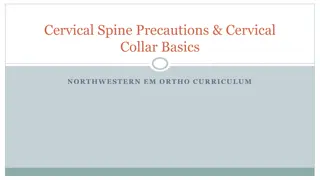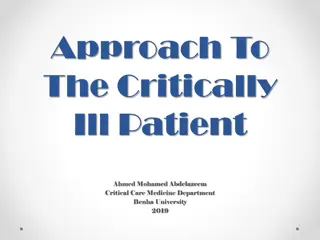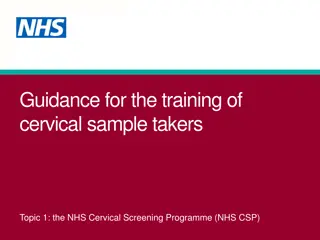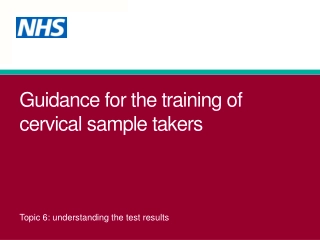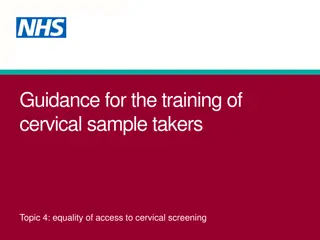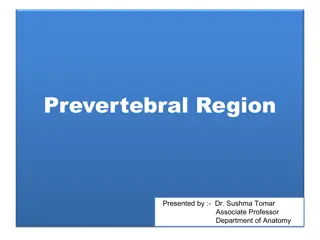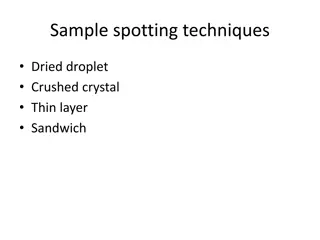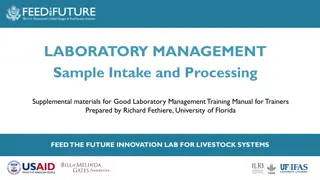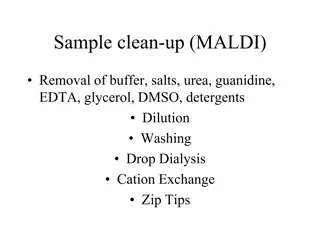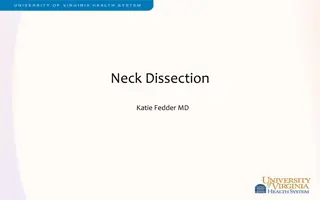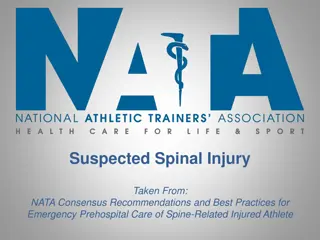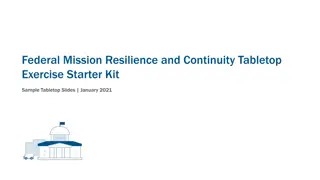Guidance for the training of cervical sample takers
Guidance provides information on organizing the NHS Cervical Screening Programme, including screening protocols, sample taker responsibilities, and access to national guidance.
- cervical screening
- NHS programme
- organization
- screening protocols
- sample taker responsibilities
- national guidance
Download Presentation

Please find below an Image/Link to download the presentation.
The content on the website is provided AS IS for your information and personal use only. It may not be sold, licensed, or shared on other websites without obtaining consent from the author. Download presentation by click this link. If you encounter any issues during the download, it is possible that the publisher has removed the file from their server.
E N D
Presentation Transcript
Guidance for the training of cervical sample takers Topic 3: organisation of the NHS Cervical Screening Programme
Note Use these slides in conjunction with the NHS Cervical Screening Programme publication Guidance for the training of cervical sample takers , available at: www.gov.uk/government/publications/cervical-screening-cervical-sample-taker- training 2 Topic 3: organisation of the NHS Cervical Screening Programme
Screening protocols (1) Each practice or clinic must have access to the national guidance for the cervical screening programme. This includes: the arrangements for call and recall the arrangements for people to be notified of their test results the content of standard letters and leaflets how to fill in the test request form correctly, recording all data requirements in accordance with the national sample acceptance policy the importance of correctly handling and labelling the sample www.gov.uk/government/collections/cervical-screening-professional-guidance www.gov.uk/government/publications/cervical-screening-accepting-samples-in- laboratories 3 Topic 3: organisation of the NHS Cervical Screening Programme
Screening protocols (2) how to obtain supplies and which ones are recommended for use approximate turnaround times for results from the local cervical screening laboratory failsafe procedures for all test results, that is the number of tests taken have received a result and are acted on (if something goes wrong, pathway processes are in place to rectify this) local arrangements for referral to colposcopy that the sample is appropriate and within the recommended screening interval in accordance with the national sample acceptance policy www.gov.uk/government/collections/cervical-screening-professional-guidance www.gov.uk/government/publications/cervical-screening-accepting-samples-in- laboratories 4 Topic 3: organisation of the NHS Cervical Screening Programme
Sample taker professional responsibilities (1) Sample taker responsibilities include: only taking samples if they have met the initial training and subsequent 3-yearly national update requirements ensuring they are on the sample taker database identifying any personal training needs understanding how the programme operates and their responsibilities within it keeping up to date with changes in the programme and current best practice in line with national guidance maintaining competency and monitoring their own results being accountable for all use of their allocated sample taker pin code 5 Topic 3: organisation of the NHS Cervical Screening Programme
Sample taker professional responsibilities (2) making sure the person has been provided with or signposted to the national information leaflet to help them make an informed choice about attending screening taking the cervical sample in the correct and appropriate manner making sure the person is informed of their test result making sure the test result is followed up communicating with the individual if their sample is rejected and advising when another sample should be taken (and reflecting on this) making sure referrals take place for individuals who require further investigation and treatment co-operating with failsafe enquiries in a timely manner making sure reasonable adjustments are offered for individuals who need additional support making sure adverse events and incidents are reported, recorded, discussed and investigated 6 Topic 3: organisation of the NHS Cervical Screening Programme
Commissioning (1) NHS England and Improvement (NHSEI) works closely with PHE and the Department of Health and Social Care (DHSC) to provide and commission a range of public health services. For cervical screening, NHS England ensures that arrangements are in place to: verify the appropriateness for the screening of people on call and recall lists make sure that eligible people who are not on NHS lists have access to screening make sure that local arrangements are made to cover residential institutions, including prisons make sure that all equipment used complies with national equipment standards make sure that staff working in the programme are trained to meet the required standards of competence and are actively involved in continuing personal and professional development 7 Topic 3: organisation of the NHS Cervical Screening Programme
Commissioning (2) This includes communicating with laboratories to ensure the provision of: sample taker databases feedback both by individual sample taker and by general practice or clinic on reporting profiles, workload and error rates (for example incomplete patient identity details) 8 Topic 3: organisation of the NHS Cervical Screening Programme
Call and recall A fundamental principle of any screening programme is to ensure that all people who are eligible for screening receive appropriate invites to participate in a timely manner. The call and recall function is an administrative process where: call is the initial invite to participate in screening for the first time recall is the invitation to participate in future rounds of screening at appropriate intervals dictated by programme policy The call and recall system: generates lists of people who are due to be invited for cervical screening sends invitation letters and reminder letters to people due for screening records test results on a person s screening history sends result letters to people to inform them of their test result 9 Topic 3: organisation of the NHS Cervical Screening Programme
General practice (1) GP practices are responsible for: understanding their contractual obligations and responsibilities in relation to cervical screening performing cervical screening tests on participants in the screening programme making sure that all members of staff involved in delivery of the cervical screening programme: o comply with national guidance and quality standards o participate in audit and review to improve the cervical screening service o are aware of mechanisms by which they can raise concerns, identify risks and report incidents o are trained in accordance to programme guidance o attend regular updates keeping records to show that the employer has monitored the above 10 Topic 3: organisation of the NHS Cervical Screening Programme
General practice (2) reporting areas of concern to their local commissioners making sure all sample takers provide people with the necessary information and are able to support people to make an informed choice about whether to accept the offer of screening making adequate arrangements and reasonable adjustments as required, to enable people to access cervical screening making sure the laboratory returns a result for each sample taken making sure processes are in place to inform people of their test results making sure failsafe is in place so test results are followed up appropriately making sure referral processes are in place so people who require further investigation and treatment are managed appropriately making sure processes are in place to respond to failsafe enquiries working to improve the uptake and coverage of the cervical screening programme 11 Topic 3: organisation of the NHS Cervical Screening Programme
General practice (3) In some circumstances a person will not want their test result to be posted to their home address, or they may not have a correspondence address. The sample taker should agree with the individual an appropriate arrangement for them to collect their test result. This should be documented on the test request. 12 Topic 3: organisation of the NHS Cervical Screening Programme
Other clinicians who provide cervical screening services Clinicians who provide cervical screening services in other settings such as integrated sexual health (ISH) clinics or genito-urinary medicine (GUM) clinics are responsible for: making sure people are provided with information and advice to enable them to make an informed choice about whether to accept the offer of screening making arrangements for taking cervical samples referring people for further investigation if necessary co-operating with laboratory failsafe enquiries In circumstances where a person does not wish the test result to be posted to their address or notified to their GP, the sample taker should agree with the individual an appropriate arrangement for them to collect the test result and appointment details for any necessary follow-up. The sample taker should document the details on the test request. 13 Topic 3: organisation of the NHS Cervical Screening Programme
Cervical screening laboratories (1) Cervical screening laboratories that participate in the NHS CSP: perform HPV testing on samples that are accompanied by an identified and completed vial and test request form or electronic request generate a cytology slide for samples testing HPV positive allocate a result code and recommendation for management depending on the degree of abnormality seen notify test results and recommendations for management to the call and recall system using standard action and result codes inform the GP or clinician responsible for requesting the test if a person requires referral for colposcopy set up and operate a laboratory failsafe system for people who require further investigation or treatment 14 Topic 3: organisation of the NHS Cervical Screening Programme
Cervical screening laboratories (2) host laboratory visits for trainee sample takers and provide trainers with supporting information (narrative) for their service which includes an overview of: o specimen reception (including rejected samples) o HPV testing o cytology slide preparation and staining o cytology screening o administration (data entry and transfer of results) may have arrangements for direct referral for colposcopy 15 Topic 3: organisation of the NHS Cervical Screening Programme
Colposcopy clinics Colposcopy clinics that participate in the NHS CSP : investigate and treat people with abnormal test results provide follow-up after treatment or discharge people back to routine recall co-operate with laboratory failsafe enquiries may take cervical samples from people referred as their cervix is difficult to visualise schedule visits for trainees to attend a clinic, and host a tour to include: o locating the colposcopy department (information for patients) o colposcopy facilities and the equipment used o communication and counselling services o an overview of direct referral and practice referral including 2 week wait o witnessing patient experiences during clinic refer an individual for colposcopy without waiting for their test result if: o an abnormality of the cervix is identified when the cervix is visualised o they have symptoms which are suspicious of abnormality 16 Topic 3: organisation of the NHS Cervical Screening Programme
Cervical screening provider lead The NHS CSP requires a cervical screening provider lead (CSPL) based in a cytology or histology laboratory or in a colposcopy clinic. The CSPL is responsible for: making sure systems are in place for transferring test results from the laboratory to the call and recall system collating histology results with cytology test results making sure laboratory failsafe measures are initiated if necessary taking a lead role in the audit of invasive cervical cancers 17 Topic 3: organisation of the NHS Cervical Screening Programme
Quality assurance (1) Quality assurance (QA) of screening programmes in England became the responsibility of Public Health England (PHE) in April 2013. The Screening Quality Assurance Service (SQAS) is part of the screening division within the PHE Health and Wellbeing directorate, and works alongside NHS screening programme teams. Cervical screening QA covers the identification of eligible people and includes: sample taking, cytology, colposcopy and histopathology. It ends with the diagnosis of cancer, completion of the screening programme at 65 years of age, or the ending of a surveillance period, whichever is later. Refer to the cervical screening programme specific operating model www.gov.uk/government/publications/cervical-screening-programme-specific- operating-model 18 Topic 3: organisation of the NHS Cervical Screening Programme
Quality assurance (2) The SQAS is responsible for: evaluating the quality of local cervical screening programmes supporting quality improvement activities arranging QA visits to laboratories and colposcopy clinics monitoring primary care elements of local cervical screening programmes advising on incident management, sharing the lessons learnt and recommendations with the programme 19 Topic 3: organisation of the NHS Cervical Screening Programme
National co-ordination PHE provides expert advice and guidance on screening to the NHS. NHS England is responsible for delivering the NHS Cervical Screening Programme, which is one of 11 population screening programmes. PHE is responsible for: improving the overall performance of the programme producing guidance and developing standards designed to assure a high quality of cervical screening supporting individuals to make an informed decision about attending for screening, through the provision of national leaflets, online content and letter templates 20 Topic 3: organisation of the NHS Cervical Screening Programme
Guidance for the training of cervical sample takers End of Topic 3. Organisation of the NHS Cervical Screening Programme 21 Topic 3: organisation of the NHS Cervical Screening Programme



